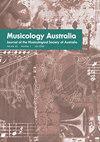Rave Music as Top Forty Pop
IF 0.4
0 MUSIC
引用次数: 0
Abstract
Abstract The late 1980s and early 1990s saw a marked increase in the number of rave tracks appearing on the UK Top Forty chart. This music appeared to have little to do with conventional song forms. Rave tracks often lacked vocals, foregrounded left-field synthesizer sounds, and eschewed the verse–chorus structures that had dominated the charts since the 1970s. This article asks: is it possible that rave music overlapped in some ways with Top Forty pop songs? I will argue that the answer to this question is a qualified ‘yes’, and that certain types of rave music functioned as a type of pop music. Rave tracks may have initially seemed quite alien to the pop charts, but they actually replicated several conventions of mainstream Western pop songs. In particular, they frequently adopted a structure resembling the verse–chorus form: verses were replaced by ‘rave’ sections, while choruses were replaced by vocal hooks, samples of existing songs, and other signifiers of pop familiarity. The article constitutes a preliminary attempt to analyse how electronic dance music functions when it is heard away from the dance floor.流行音乐四十强
摘要20世纪80年代末和90年代初,英国四十强排行榜上出现的锐舞曲目数量显著增加。这种音乐似乎与传统的歌曲形式没有什么关系。Rave曲目通常缺乏人声、突出的左场合成器声音,并避开了自20世纪70年代以来一直在排行榜上占据主导地位的诗歌合唱结构。这篇文章问道:锐舞音乐是否可能在某些方面与四十大流行歌曲重叠?我认为这个问题的答案是一个合格的“是”,某些类型的锐舞音乐就像一种流行音乐。Rave歌曲最初在流行榜上可能看起来很陌生,但它们实际上复制了西方主流流行歌曲的几种惯例。特别是,他们经常采用类似诗歌的结构——合唱形式:诗歌被“锐舞”部分取代,而合唱则被人声钩、现有歌曲样本和其他流行熟悉的能指取代。本文初步尝试分析电子舞曲在远离舞池的地方是如何发挥作用的。
本文章由计算机程序翻译,如有差异,请以英文原文为准。
求助全文
约1分钟内获得全文
求助全文

 求助内容:
求助内容: 应助结果提醒方式:
应助结果提醒方式:


